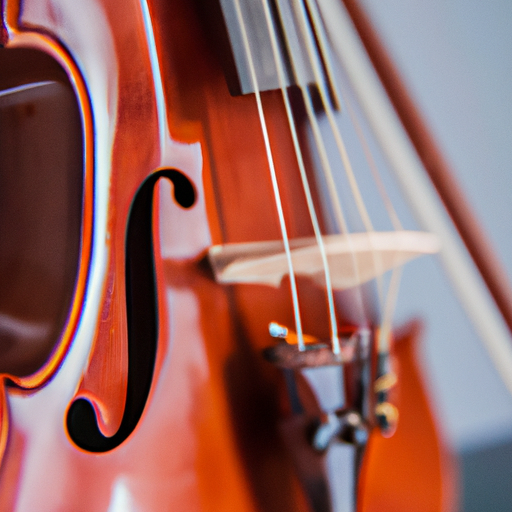
When it comes to learning the violin, beginners often face numerous challenges. However, with easy violin tips, beginners can navigate the initial hurdles and make progress in their musical journey. These tips provide guidance and techniques that simplify the learning process, making it easier for beginners to grasp the fundamentals of playing the violin.

Learning to play the violin offers a multitude of benefits. It improves coordination, enhances concentration, and promotes discipline. Playing the violin also enhances cognitive abilities, boosts self-confidence, and provides an avenue for self-expression. Additionally, it offers a lifelong source of joy and fulfillment.

Easy violin tips specifically cater to beginners by breaking down complex techniques and concepts into simpler steps. These tips help beginners overcome initial challenges, build a strong foundation, and progress steadily. By implementing these tips, beginners can develop good habits, prevent common mistakes, and lay a solid foundation for advanced violin playing.
Proper posture is essential for playing the violin. It promotes correct body alignment, allowing for better control and ease of movement. Good posture also helps prevent muscle strain, reduces the risk of injury, and enhances sound production. It is the foundation for developing a solid technique.
To achieve proper posture, beginners should stand or sit straight with their feet flat on the floor. The violin should be held at a comfortable height, with the chin resting on the chinrest. The left hand and elbow should be relaxed, and the right arm and wrist should be flexible. Regular self-checks should be done to maintain proper posture during practice sessions.
Proper posture not only improves playing technique but also prevents strain and injury. It allows for better control over the bow and finger placement, leading to improved sound production. Additionally, good posture ensures a comfortable playing experience, enabling beginners to play for longer periods without discomfort.
Proper bow holding is crucial for producing a good tone. Beginners should hold the bow with a relaxed grip, placing the thumb on the bottom of the frog. The remaining fingers should lightly rest on the bow, with the pinky slightly curved. The bow should be balanced and controlled between the index finger and thumb.
Some common mistakes to avoid while holding the bow include gripping it too tightly, letting the fingers collapse or press too hard, and not maintaining a relaxed hand position. These mistakes can hinder sound production and lead to tension in the hand and arm.
To improve bow holding, beginners can practice exercises that focus on finger flexibility, finger independence, and maintaining a relaxed grip. Additionally, seeking guidance from a qualified violin teacher can help identify and correct any bow holding issues.
Proper finger placement is crucial for producing accurate and clear notes. Beginners should start by placing their fingers on the fingerboard with a curved shape and the fingertips touching the strings. The fingers should be close to the strings without pressing too hard, allowing for optimal sound production.
Strengthening fingers is an important aspect of violin playing. Finger exercises such as finger lifts, spider crawling, and finger stretches can help build finger strength and dexterity. Regular practice and repetition of these exercises contribute to improved finger control.
Exercises that focus on finger placement include scales, arpeggios, and finger pattern drills. These exercises help train the muscle memory and develop accuracy in finger placement. Practicing them regularly improves intonation and facilitates the transition between notes.
Mastering different bowing techniques is vital for expressive violin playing. Techniques such as legato, staccato, spiccato, and détaché allow for a wide range of musical expression and dynamics. Each technique has its own unique characteristics and is used in various musical passages.
To perform each bowing technique, beginners should focus on the right arm's motion, maintaining a relaxed wrist, and controlling the speed and pressure applied to the strings. Various exercises, such as bowing with different rhythms and articulations, can help refine these techniques.
Exercises that specifically target bowing techniques include scales with varied bowing styles, bowing patterns on open strings, and etudes that focus on specific bowing techniques. Consistent practice of these exercises helps develop control, precision, and fluidity in bowing.
Choosing the right violin is crucial for beginners. Factors to consider include the size, quality, sound projection, and playability of the instrument. Trying out multiple violins, seeking guidance from a knowledgeable violinist or luthier, and considering the budget are essential when making a decision.
When choosing a violin, beginners should consider factors such as their skill level, long-term goals, and budget. They should also assess the instrument's construction, sound quality, and playability to ensure a comfortable and enjoyable playing experience.
Good violins can be found at reputable violin shops, music stores, or through private sellers. Renting a violin initially can be a cost-effective option for beginners. Online platforms that specialize in violin sales also offer a wide range of options. Seeking guidance from a violin teacher or experienced violinist can provide valuable insights on where to find a good violin.
Tuning the violin is essential for achieving accurate pitch and maintaining harmony while playing. Beginners can use a tuner, tuning fork, or a piano to tune the violin's strings. The strings should be adjusted by turning the fine tuners or pegs until they produce the desired pitch.
Tuning the violin ensures that the instrument is in harmony with other musicians or accompanying instruments. It also trains the ear to recognize accurate pitch and helps develop a sense of intonation. Playing in tune enhances the overall sound quality and musicality.
To maintain the violin's tune, beginners should regularly check the strings' tension and make adjustments as necessary. Extreme temperature changes, humidity, and excessive playing can cause the strings to go out of tune. Using fine tuners and pegs appropriately and regularly replacing old and worn-out strings can also help maintain the violin's tune.
Effective practice is essential for progress in violin playing. Beginners should establish a regular practice routine, setting specific goals and allocating dedicated time for practice. Breaking down challenging passages into smaller sections, using a metronome, and focusing on technique are key components of effective practice.
To make practice sessions enjoyable, beginners can incorporate various techniques. They can mix up practice routines, alternate between technical exercises and musical pieces, and experiment with different musical styles. Setting achievable short-term goals and rewarding oneself after reaching milestones can also add motivation and fun to practice sessions.
Consistent practice is vital for progress and skill development. Regular practice builds muscle memory, improves finger dexterity, and reinforces technique. It also enhances concentration, aural skills, and overall musicianship. Committing to consistent practice ensures steady improvement in violin playing.
Various accessories can enhance the violin playing experience. These include a shoulder rest, rosin, a music stand, and a violin case. Each accessory serves a specific purpose in providing comfort, improving sound quality, and protecting the violin.
A shoulder rest provides support and helps maintain proper posture. Rosin enhances the bow's friction, improving sound production. A music stand ensures proper sheet music placement for easy visibility. A violin case protects the instrument from damage and facilitates safe transportation.
Investing in a comfortable and adjustable shoulder rest is recommended for beginners. Choosing a good-quality rosin suitable for the violin's strings is also important. A sturdy and portable music stand is beneficial for practice sessions. Lastly, investing in a durable and well-padded violin case ensures the instrument's safety.
Beginners often encounter common problems such as squeaky or scratchy sounds, intonation issues, bow bouncing, and finger placement inaccuracies. These problems are part of the learning process and can be overcome with proper guidance and practice.
Addressing common problems involves identifying the root cause and implementing targeted solutions. Working on bowing technique, practicing scales for intonation, and focusing on finger placement exercises can help address these issues. Seeking guidance from a violin teacher or experienced violinist can provide valuable insights and solutions.
Seeking professional help when encountering persistent or complex problems is crucial. A qualified violin teacher can offer personalized guidance, assess technique, and provide solutions tailored to individual needs. Professional guidance ensures efficient problem-solving and prevents the development of bad habits.
Easy violin tips for beginners provide invaluable guidance, simplifying the learning process and enabling beginners to progress confidently. These tips address various aspects such as posture, bowing, finger placement, tuning, and practice techniques. Implementing these tips helps beginners build a solid foundation for their violin playing journey.
Learning the violin is a rewarding journey that requires dedication and perseverance. Beginners should remain motivated, continue practicing regularly, and embrace the learning process. With consistent effort and a positive mindset, progress and improvement are attainable.
Easy violin tips for beginners serve as a roadmap to success in violin playing. By following these tips, beginners can overcome challenges, develop strong foundations, and enjoy the journey of learning the violin. With patience, practice, and a passion for music, beginners can unlock their potential and experience the joy of playing this beautiful instrument.
For more information, you can visit Easy Violin Tips for Beginners.